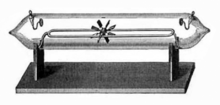Katodová trubice
Katodová trubice je obvykle skleněná, více či méně vakuovaná či zředěným plynem plněná baňka či trubice, osazená minimálně dvěma elektrodami (anodou a studenou či žhavenou katodou), mezi nimiž po připojení k elektrickému napětí prochází v prostředí trubice elektrický proud. Konstrukce katodových trubic se velmi liší podle účelu, k nimž jsou konstruovány.
Funkce
Stěnou baňky či trubicemi prochází hermeticky zatavené elektrody. Po přiložení dostatečně vysokého elektrického napětí na tyto elektrody začne uvnitř trubice mezi elektrodami procházet elektrický proud, přičemž dochází ke vzniku tzv. katodového (proud elektronů z katody směrem k anodě) a kanálového (proud kladných iontů směrem ke katodě) záření. Charakter záření závisí na tlaku plynů uvnitř trubice. Kladné ionty vznikají interakcí elektronů vyletujících z katody s molekulami plynové náplně. Se snižujícím se tlakem plynů uvnitř trubice (tedy se snižujícím se počtem molekul plynu) se snižuje i počet ionizací a v trubici převládá katodové záření. Výzkum katodového záření sehrál významnou roli ve výzkumu složení hmoty a také vedl k objevu rentgenového záření.
Katodová trubice je základem konstrukce mnoha součástek, jakými jsou např. světelné výbojky, rentgenky či obrazovky.
Rozdělení katodových trubic
- experimentální
- světelné zdroje (různé výbojky)
- elektronky
- vakuové obrazovky (CRT)
- rentgenky
Související články
Externí odkazy
 Obrázky, zvuky či videa k tématu obrazovka na Wikimedia Commons
Obrázky, zvuky či videa k tématu obrazovka na Wikimedia Commons - Encyklopedie fyziky – Katodové a kanálové záření, obrazovka
- Katodové záření, elektronky Archivováno 22. 12. 2009 na Wayback Machine
Média použitá na této stránce
Drawing of an experimental Crookes tube with a paddlewheel inside, built by William Crookes around 1879. It was called the 'railway' tube, since as the paddlewheel turned it slowly rolled down the rails from one end of the tube to the other. The purpose of the tube was to determine whether cathode rays had mass. The tube was evacuated to a pressure of about 10-6 to 10-7 atmosphere. When the electrodes at each end of the tube were attached to a source of high voltage DC electricity, a beam of cathode rays (electrons) passed down the tube from the cathode to the anode. The upper paddles of the light paddlewheel were in the path of the beam. Crookes found that when the voltage was applied the paddlewheel turned in a direction away from the cathode. He concluded that the momentum of the rays was providing the force which turned the wheel, indicating that cathode rays had mass. However in 1903, J. J. Thompson showed that the motion of the paddlewheel was actually caused by the radiometer effect. When the cathode rays struck the paddle, they heated it. The air next to the hot side of the paddle expanded, pushing the paddle away. All this experiment really showed was that cathode rays could heat objects. Alterations to image: removed figure number and yellowish tint to page, converted to 32 greyscale PNG.

